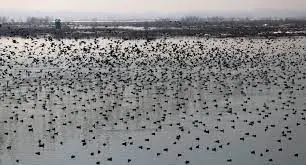Over two lakh migratory birds have trickled into the wetlands of Kashmir, seeking refuge from the harsh winter in their native habitats in Siberia, Northern Europe and Central Asia. According to Kashmir Media Service, these birds embark on a challenging journey, covering thousands of miles through various countries to reach the Valley before winter. Beginning in October, the birds gradually move into the wetlands, and by March, all nine wetlands of the Valley are bursting with colourful birds, producing a mesmerising sight that lasts for almost six months.
“They stay in our various wetlands and other water bodies for about six months. When the water freezes due to drop in temperature, these birds move to other parts of India,” Ifshan Dewan, Wildlife Warden for Kashmir Wetlands, told the media.
She shared that nearly two lakh migratory birds have already been welcomed in all nine wetlands of the Valley, with expectations of an increase in avian visitors in the upcoming months. “With each passing day, the bird count is increasing, and by February, the wetlands will be teeming with birds,” she said.
Ifshan Dewan added that the annual bird census in February consistently reveals 60 to 70 different bird species in the Valley.
According to Ifshan Dewan, the yearly Asian waterfowl census, conducted collaboratively with universities, NGOs, and bird-watching organisations, recorded an impressive count of almost 10 lakh birds last year. “We are expecting the same number this year as well,” she said.
Among the nine wetlands, Hokersar stands out as the most frequented, while the Chatlam Wetland in Pampore, South Kashmir, has seen an increase in bird visits since the 2014 floods, offering locals hope for future tourism potential. —KMS










